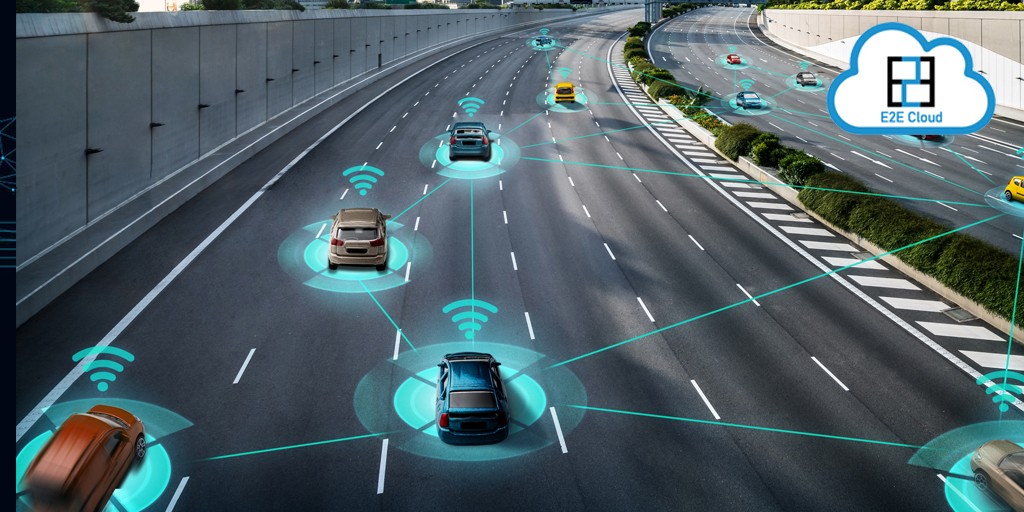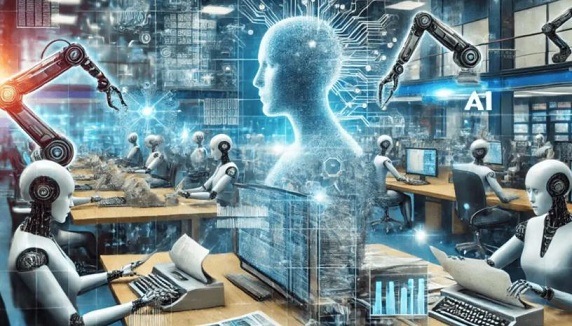Stories you may like
AI in Automotive: Driving the Future of Transportation
Artificial intelligence is changing the way we think about cars and driving. AI helps make vehicles safer, smarter, and more efficient. It's being used to develop self-driving cars, improve safety features, and enhance the overall driving experience.
AI is revolutionizing the automotive industry by enabling advanced driver assistance systems, predictive maintenance, and personalized in-car experiences. These innovations are not just making our roads safer, but also transforming how we interact with our vehicles. From voice-controlled infotainment systems to AI-powered navigation, cars are becoming more like personal assistants on wheels.
The impact of AI extends beyond the vehicles themselves. It's reshaping manufacturing processes, supply chain management, and even how car companies market their products. As AI continues to evolve, we can expect to see even more exciting changes in the automotive world.
Key Takeaways
-
AI is making cars safer and smarter through advanced driver assistance systems
-
Self-driving technology is rapidly advancing thanks to artificial intelligence
-
AI is transforming automotive manufacturing and customer experiences
The Role of AI in the Evolution of the Automotive Industry
AI is changing cars and how they're made. It's making factories smarter, improving how cars are fixed, and adding new features to vehicles.
Impact on Automotive Manufacturing
AI makes car factories work better. Robots guided by AI can put cars together faster and with fewer mistakes. These smart robots learn and improve over time.
AI also helps predict when machines might break down. This keeps production lines running smoothly. Factories use AI to check the quality of parts and finished cars.
Computer vision systems spot defects that human eyes might miss. This means fewer faulty cars leave the factory.
AI also helps design factory layouts for maximum efficiency. It can suggest the best way to arrange equipment and workflow.
Disruption in Service and Maintenance
AI is changing how cars are fixed and maintained. Smart diagnostic tools can find problems before they get big.
These tools look at data from sensors all over the car. They can tell mechanics exactly what's wrong and how to fix it.
AI chatbots help car owners with basic questions and maintenance tips. This saves time for both customers and service centers.
Predictive maintenance systems use AI to guess when a car will need service. They look at how the car is driven and its condition.
This means fewer surprise breakdowns and more efficient servicing. Some new cars can even schedule their own service appointments.
Transformation in Vehicle Design and Features
AI is adding new features to cars. Self-driving technology is the biggest change. AI helps cars see the road, make decisions, and drive safely.
Voice assistants powered by AI let drivers control things hands-free. They can adjust the temperature, play music, or get directions just by talking.
AI improves safety features like emergency braking and lane-keeping. These systems react faster than humans and can prevent accidents.
Car designs are getting smarter too. AI helps engineers test new designs virtually before building them. This leads to cars that are safer, more efficient, and better looking.
AI even helps cars learn their owners' preferences. They can adjust seats, mirrors, and climate based on who's driving.
Advancements in Autonomous Driving Technologies
Self-driving cars are getting smarter. New tech helps them see and understand the world better. This lets them drive more safely on their own.
The Emergence of Self-Driving Cars
Self-driving cars use AI to navigate roads without human input. They rely on sensors, cameras, and computers to make decisions. Early versions needed lots of human help. Now, some can drive in many situations on their own.
Companies like Tesla, Waymo, and GM are leading the charge. Their cars can change lanes, park, and follow traffic rules automatically. Some even work as robo-taxis in certain cities.
But fully self-driving cars aren't common yet. Most still need a human ready to take over. As the tech improves, we'll likely see more on the roads soon.
Advances in Computer Vision and Object Detection
Computer vision is key for self-driving cars. It lets them "see" and understand their surroundings. Recent AI breakthroughs have made this much better.
Cars can now spot road signs, other vehicles, and pedestrians more accurately. They can read lane markings and traffic lights too. This helps them follow rules and avoid crashes.
Key improvements:
-
Faster processing of visual data
-
Better identification of objects in bad weather
-
More accurate prediction of other drivers' actions
These advances make self-driving cars safer and more reliable in complex traffic situations.
Lidar and Radar in Autonomous Vehicles
Lidar and radar help self-driving cars "see" in 3D. They work even when cameras can't.
Lidar uses lasers to map the area around the car. It's very precise but can be expensive. Newer, cheaper versions are making it more common in cars.
Radar uses radio waves to detect objects. It works well in bad weather and is less costly than lidar. Recent advances have made it more accurate.
Many cars use both lidar and radar along with cameras. This gives them a complete view of their surroundings. It helps them drive safely in all conditions.
As these sensors get better and cheaper, self-driving cars will become more capable and affordable.
Artificial Intelligence and Vehicle Safety
AI is making cars safer in several key ways. It helps prevent accidents, assists drivers, and monitors for dangerous situations. Let's look at some important safety features powered by AI.
Advanced Driver-Assistance Systems (ADAS)
ADAS uses AI to help drivers avoid crashes. These systems can warn about nearby obstacles or vehicles in blind spots. Some ADAS features include:
• Lane departure warnings • Adaptive cruise control • Parking assistance
AI allows ADAS to process data from sensors and cameras in real-time. This quick analysis helps spot potential dangers faster than a human could.
ADAS is becoming standard in many new vehicles. As the technology improves, these systems will likely get even better at preventing accidents.
Automatic Braking and Accident Prevention
AI-powered automatic braking systems can react faster than human drivers. They use sensors to detect objects in the road ahead. If a collision seems likely, the system will apply the brakes.
This technology has been shown to reduce rear-end crashes by about 50%. It's especially helpful for avoiding accidents caused by distracted driving.
Some systems can also steer the car to avoid obstacles. As AI improves, these accident prevention features will become more advanced.
Driver Monitoring Systems
AI cameras and sensors inside the car can track driver behavior. These systems look for signs of:
• Drowsiness • Distraction • Impairment
If risky behavior is detected, the system will alert the driver. Some cars can even slow down or pull over if the driver doesn't respond.
This technology aims to prevent accidents caused by human error. It may be especially useful for commercial fleets to ensure driver safety.
AI monitoring can also be used to coach drivers on safer habits over time.
Enhancing Driving Experience with Machine Learning
Machine learning is changing how we drive and interact with our cars. It makes trips easier, safer, and more fun. New tech helps with navigation, voice controls, and entertainment.
Navigational Systems and Predictive Analytics
Smart navigation systems use machine learning to find the best routes. They look at traffic data, road conditions, and past trips. This helps drivers avoid jams and get to their destinations faster.
These systems can:
-
Predict traffic patterns
-
Suggest alternate routes in real-time
-
Learn a driver's favorite places
Some cars even use cameras and sensors to spot road signs and hazards. This info helps keep maps up-to-date and warns drivers of dangers ahead.
Voice Recognition and In-Car Connectivity
Voice controls make it easy to use car features without taking hands off the wheel. Machine learning helps these systems understand different accents and speech patterns.
Drivers can:
-
Change radio stations
-
Make phone calls
-
Adjust climate settings
Cars can also connect to smartphones and smart home devices. This lets drivers control their homes from the road or check their car's status from their phone.
Customized Entertainment and Recommendation Engines
Machine learning powers in-car entertainment systems that learn what drivers like. These systems can suggest music, podcasts, or audiobooks based on past choices and driving conditions.
Features include:
-
Playlists that match the length of a trip
-
Content recommendations for passengers
-
Adjusting volume based on road noise
Some cars even use cameras to detect driver mood and play fitting music. As machine learning gets better, cars will offer more personalized and enjoyable rides.
Intelligent Fleet Management Solutions
AI is transforming how companies manage their vehicle fleets. Smart systems are making maintenance, fuel use, and operations more efficient. These solutions help fleets run better and save money.
Predictive Maintenance with AI
AI-powered systems can spot potential vehicle issues before they cause breakdowns. These tools analyze data from sensors and past repairs to predict when parts might fail. This lets fleet managers schedule fixes at the best times.
Predictive maintenance cuts repair costs and vehicle downtime. It also boosts safety by catching problems early. Some AI systems can even order parts automatically when needed.
Fleet companies using predictive maintenance have seen big drops in unexpected repairs. This keeps more vehicles on the road and working.
Optimization of Fuel Efficiency and Logistics
AI helps fleets use less fuel and plan better routes. Smart systems look at traffic, weather, and delivery schedules to find the best paths for drivers.
These tools can also track how drivers operate vehicles. They spot habits that waste gas, like harsh braking or speeding. Managers can then coach drivers to be more fuel-efficient.
AI route planning has helped some fleets cut fuel use by up to 15%. It also means faster deliveries and happier customers.
Use of Digital Twins in Fleet Operations
Digital twins are virtual copies of real vehicles. They let managers test ideas without risking real trucks or cars.
These digital models show how vehicles perform in different conditions. Managers can try new routes or maintenance plans safely on the computer.
Digital twins help fleets make smarter choices about buying and using vehicles. They can test how new tech or changes might work before spending money.
Some companies have used digital twins to boost fleet productivity by over 20%. This tech helps fleets run smoother and adapt faster to changes.
The Integration of Electric Vehicles with AI
AI plays a key role in making electric vehicles smarter and more efficient. It helps manage energy use and boosts vehicle performance in important ways.
Smart Energy Management Systems
AI-powered systems in electric cars help use energy wisely. They can predict how much power the car needs for a trip. This lets drivers plan better and avoid running out of charge.
These systems also learn from driving habits. They adjust power use to match each driver's style. This makes the car more efficient over time.
AI can even help with charging. It can find the best times to charge based on electricity rates. This saves money for drivers.
Some cars use AI to balance power between different systems. This keeps everything running smoothly without wasting energy.
AI in Enhancing Electric Vehicle Performance
AI makes electric cars perform better on the road. It can adjust how the car handles based on road conditions. This gives drivers a smoother, safer ride.
The car's computer can learn about common routes. It then optimizes power use for those trips. This helps the car go farther on a single charge.
AI also helps with maintenance. It can spot problems early by looking at how the car is running. This keeps the car in good shape and avoids breakdowns.
Some AI systems help with self-driving features. They make decisions about steering, braking, and acceleration. This can make driving easier and safer for people.






User's Comments
Diana loreens Reply
It’s fascinating to see how AI is transforming the automotive world, from autonomous driving to predictive maintenance and smarter traffic management. Reading about these innovations really makes me appreciate how technology can enhance both safety and efficiency on the road. Personally, I’ve been exploring ways to get involved in this evolving industry, and finding vehicles for hands-on projects has been essential. That’s why I often check out platforms like Autobidmaster, where you can search for scratch and dent car with potential for restoration or experimentation. It’s an excellent resource for anyone wanting practical experience with cars while engaging with AI-driven automotive trends, making the future feel more tangible.